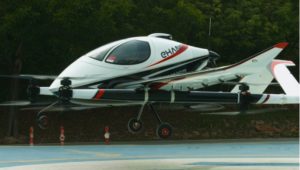
The project involves 15 partners from the research community and the drone and manned aviation industries, working to ensure interoperability and enable secure (data) communication between airborne and ground-based systems. “This creates a “system of systems” that combines classic air traffic management and new and improved drone-specific services,” says the press release. Estonian Air Navigation Services (EANS), Dimetor, Airbus Urban Mobility GmbH, Aviamaps, CAFA Tech, DroneRadar, EHang, Fintraffic ANS, Frequentis, PCSS Poznańskie Centrum Superkomputerowo-Sieciowe, Polish Air Navigation Services Agency, Robots.Expert, Threod Systems, Unmanned Life, and Vaisala are all collaborating on Project GOF 2.0.
It’s All About Integration
Airspace integration is a key goal for airspace authorities all around the world. Integrating unmanned aircraft data into existing systems designed for manned aircraft and significantly less air traffic than the commercial drone industry could present is a major challenge. Project GOF 2.0 Urban Airspace Validation, partners are working to ensure that their systems are interoperable.
The integrations between partner systems developed as part of the project will be validated in various European countries together with the air traffic control authorities since April 2022. St. Georgen am Ybbsfeld Airport – not far from Amstetten / Lower Austria – was chosen for the Austrian validation. In this trial, among other things, automated parcel delivery at low-altitude and its safe interaction with air taxi flights and conventional air traffic were extensively tested as an example of a realistic use case.
“It is of utmost importance that we can integrate drone traffic control systems directly into our air traffic management systems and ensure a safe and smooth operation,” explains Günter Graf, Vice President New Business Development and Innovation at Frequentis, the Austrian GOF 2.0 partner and host of this validation. “Many thanks to our partners for the good cooperation and their attendance with us in Austria. The team is working excellently, and the results are promising.”
The successful test flights “underline the technical possibilities as well as the future challenges to integrate simultaneous unmanned flights into urban airspace shared with manned aviation,” says the press release.
“GOF2 demonstrations highlight the importance of integrating U-space information directly into drone operator mission control systems“, says Jonas Stjernberg, SVP and Partner at Robots.Expert, and continues, “the biggest challenge for the industry and regulators is to ensure that U-space systems are interoperable on a European level.”
This project has received funding from the SESAR 3 Joint Undertaking under the European Union’s Horizon 2020 research and innovation programme under grant agreement No 101017689. More information can also be found on the project website: www.gof2.eu.
Read more about U-Space, SESAR, and European drones regulations:
- The U-Space Deadline is January 2023. What Has to Happen Before That? A Conversation with ANRAs Amit Ganjoo
- France Chooses 8 UTM Providers to Create a “Best of Breed” Integrated Solution: U-Space Together
- European Drone Regulations: EASA Basic Regulation, and What’s Next
- European Drone Regulations: Expert Perspectives
Miriam McNabb is the Editor-in-Chief of DRONELIFE and CEO of JobForDrones, a professional drone services marketplace, and a fascinated observer of the emerging drone industry and the regulatory environment for drones. Miriam has penned over 3,000 articles focused on the commercial drone space and is an international speaker and recognized figure in the industry. Miriam has a degree from the University of Chicago and over 20 years of experience in high tech sales and marketing for new technologies.
For drone industry consulting or writing, Email Miriam.
TWITTER:@spaldingbarker
Subscribe to DroneLife here.